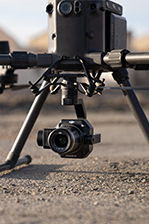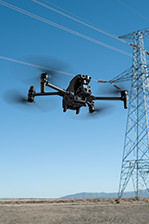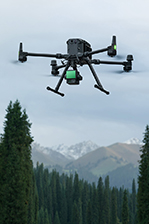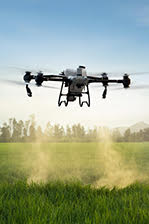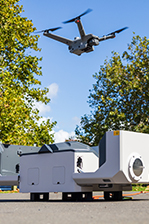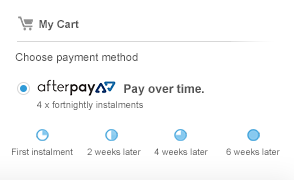Compact and Lightweight Gimbal for Content Creators
Introducing DJI RS 4 Mini, the all-new compact and lightweight gimbal for content creators. Featuring automated axis locks, intelligent tracking and composition, Teflon™ enhanced balancing, and 3rd-gen native vertical shooting, it empowers content creators and independent commercial videographers to roll with it in a more efficient and seamless filming experience.
Product Highlights
2nd-Gen Automated Axis Locks
Responsive Follow Mode
Faster Vertical Switch
Teflon™ Enhanced Balancing
Intelligent Tracking and Composition [1]
Handles Cameras and Smartphones [2]
![]()
A Fresh Take On the Classic
Faster Setup - 1s Unlock, Start Filming Right Away
DJI RS 4 Mini adds auto axis locks previously found on DJI's flagship gimbals, which allow the three axis locks to automatically unlock upon power-on and lock upon power-off or sleep. This noticeably speeds up the filming, transitioning, and storage processes. The storage structure has also been upgraded, with the axis arms folding flatter to save space. Combined with automated axis locks, the gimbal can be stored quickly with the press of a button, making it easy to fit into a bag for convenient carrying.
Faster Vertical Switch
RS 4 Mini offers the fastest switch between horizontal and vertical shooting in the RS series. [3] To switch to vertical shooting, simply loosen and press the single-side knob, remove the gimbal's horizontal plate, rotate it 90°, and then tighten it back in place. All can be done in 10 seconds. This way, you can directly shoot vertical videos, perfectly suited for mobile phone viewing, letting your audience enjoy your masterpiece even sooner.
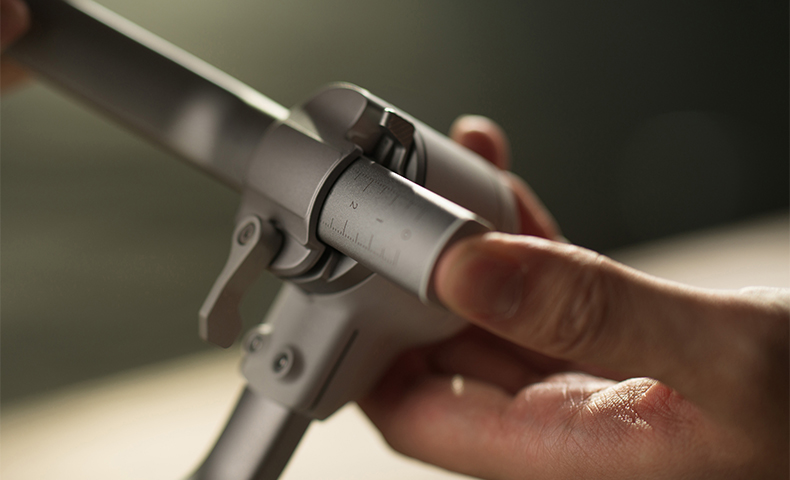
Threefold Ease for Balancing
Finding it difficult to balance when installing a camera? RS 4 Mini has been meticulously upgraded by adding Teflon™ interlayers [4] previously used on DJI's flagship gimbals, reducing friction for smoother balancing.
The new fine-tuning knob on the tilt axis can move the camera forward or backward, achieving precise, millimeter-level balancing.
The upper quick-release plate adds three positioning slots, allowing you to choose different installation positions based on your camera, offering more balancing space. When you need to remove the camera from the gimbal and reattach it, it also aids in memory for quick repositioning without affecting the balancing.
Versatility - Handles Cameras and Smartphones
The lightweight RS 4 Mini offers a payload capacity of 2 kg (4.4 lbs), effortlessly handling combinations like the Sony A7 series mirrorless camera with a 24-70 mm F2.8 GM II lens, as well as vlog cameras like the Sony ZV series. When paired with DJI Mic series microphones [5], fill lights, and other accessories, it still allows for smooth camera movements. [6] You can also quickly switch to a smartphone stabiliser using the new Phone Holder. [7] Its versatility seamlessly adapts to different scenarios.
Wireless Recording and Zoom
After Bluetooth pairing [6], you can control the start/stop of recording of your camera or phone directly via the gimbal's record button, without the hassle of a cable release. The new zoom control function allows you to control Power Zoom for PZ lenses and Clear Image Zoom simply by pushing the joystick, making one-handed operation a breeze. A camera only needs to be paired once, after which it can reconnect seamlessly and automatically.
Thoughtful UI Upgrades
The touchscreen now displays icons more clearly and runs more smoothly. New gimbal status prompts have been added, and when customizing parameters, you can fine-tune values directly using the front dial. The touchscreen incorporates an auto-lock feature. Once locked, the screen will display the current gimbal and joystick modes at a low brightness. This not only prevents accidental touches but also helps to conserve battery power.
Briefcase Handle for Mini
We have developed a next-gen briefcase handle [8] specially for RS 4 Mini, reducing the size by about 20% [9] and the weight by about 12% [9], making low-angle handheld filming more effortless.
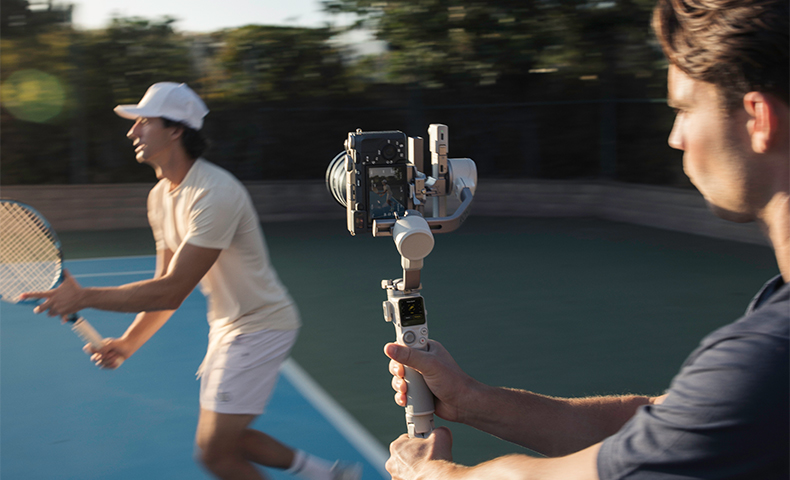
Innovative Filming for Stunning Results
New DJI RS Intelligent Tracking Module
Making Follow Shots a Walk in the Park
Introducing DJI RS Intelligent Tracking Module [7], an RS 4 series' new universal accessory. It assists novice videographers in intelligent follow-filming and composition [10], keeping the human subject in a consistent position within the frame. This is particularly useful for orbit shots, backward tracking shots, and for tracking yourself from a fixed camera position when filming alone. The module supports tracking up to 10 meters, and functions reliably even in complex scenes, such as multi-person environments. Even if the subject temporarily leaves the frame, the gimbal can find and follow the subject again. [11]
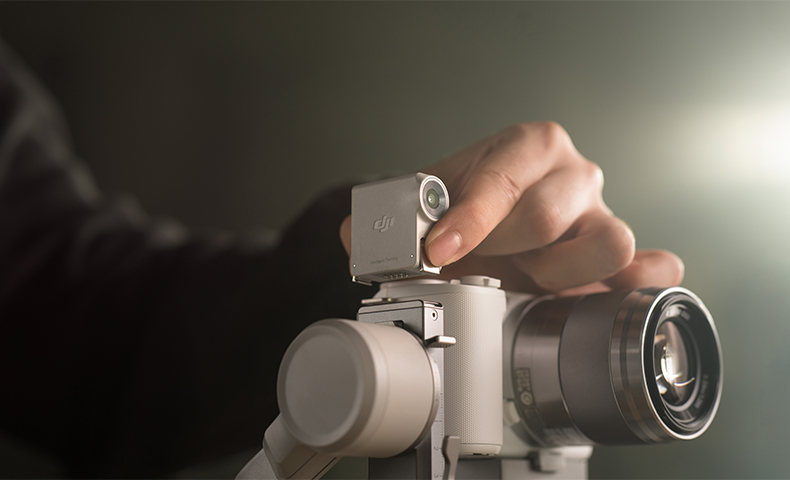
1s Secure Magnetic Mount
The tracking module features a magnetic quick-release design, allowing it to attach to the tilt axis in just one second and be ready to work with the gimbal. Thanks to the magnetic locking design, it will stay securely in place without loosening or falling off, ensuring a more reliable filming process.
1s Start/Stop of Tracking
With just one press of the trigger, you can instantly lock onto your subject and start or stop intelligent tracking, effortlessly keeping up with your star of the show. Or open your palm towards the tracking module, and it will detect you as the subject within 1 second and start/stop intelligent tracking, perfect for selfies and vlogs.
Responsive Follow
In the new Responsive mode, the gimbal responds faster to hand movements upon start and stop, especially suitable for fast orbit shots.
It also retains DJI's classic Smooth follow mode, providing fluid gimbal response, making it ideal for regular follow shots or parallel tracking. By combining different follow modes and speeds, you can create a wide range of narratives.
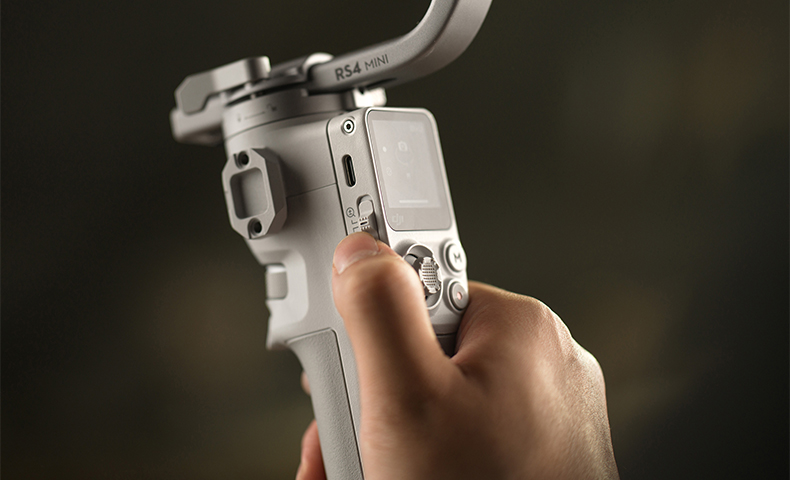
4th-Gen Stabilisation
RS 4 Mini has upgraded to the 4th-Gen RS Stabilisation Algorithm. It strikes a superior balance between stabilisation strength and the tactile feel of camera movement, delivering both excellent performance and an enhanced user experience. Additionally, RS 4 Mini offers significantly improved stability when vertical shooting, easily steadying dynamic shots like running or low-angle perspectives. Moreover, the gimbal is optimized for compatibility with various cameras, automatically calibrating motor strength to adapt to different scenarios.
Fast Charge, Extended Battery
Both the charging speed and battery life increase by 30% [12] compared to the last generation. With a 13-hour [13] max operating time, it provides ample power for all-day filming. It also supports fast charging, offering a 5-hour [13] use with just a 30-minute charge.
Lightweight Build, High Payload
Weighing only 890 g (2 lbs), RS 4 Mini boasts a payload capacity of up to 2 kg (4.4 lbs). It supports a wide range of mainstream mirrorless cameras and lens combinations, delivering powerful performance. [6] It can support a Sony A7 series camera with a 24-70 mm F2.8 GM II lens, along with a DJI Mic series microphone receiver [5]. With high-torque motors, RS 4 Mini can retain stable shooting when zooming to max focal lengths when using the following recommended combinations without the need for rebalancing.
- Canon R5 + RF 24-70 mm F2.8
- Sony A7S3 + FE 24-70 mm F2.8 GM2
- Nikon Z7 2 + Z 24-70 mm F2.8
- Panasonic S5 + L 20-60 mm F3.5-5.6
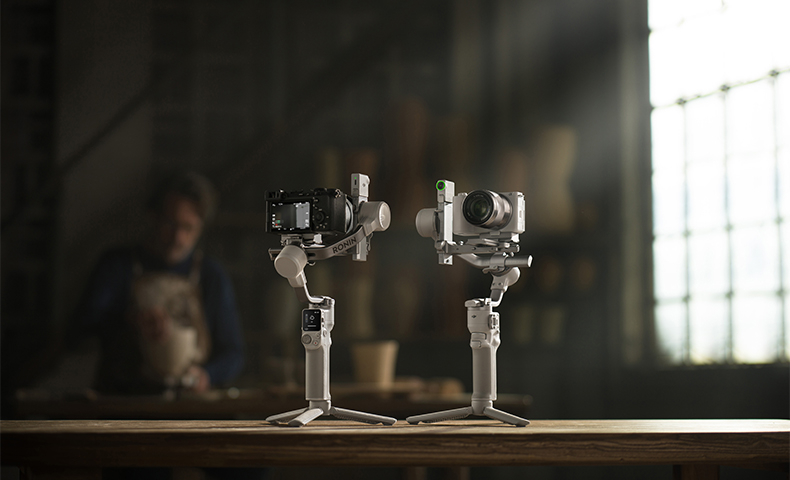
Notes
- Requires purchasing the DJI RS Intelligent Tracking Module.
- Smartphone use requires the DJI RS 4 Mini Phone Holder, which is sold separately.
- Conclusion based on data as of February 2025.
- Used on pan and roll axes.
- For more details on the camera compatibility of the DJI Mic series products, please refer to the product page on the DJI official website. Limited by balancing space, some cameras do not support the use of the hot shoe adapter and can only be connected to the mic's receiver via cable.
- Check the camera compatibility list for detailed information on supported camera models.
- Sold separately.
- Requires purchasing a specific combo.
- Compared with the DJI RS Briefcase Handle.
- Only supported in the PF (pan follow) and PTF (pan and tilt follow) modes. Not supported in the FPV (pan, tilt, and roll follow) mode.
- The maximum limit for multi-person environments is three people. The follow distance data was measured in a controlled laboratory environment. Actual experience may vary.
- Compared with DJI RS 3 Mini.
- Measured with the equipment in a level and stationary state and the gimbal balanced. When the gimbal is in motion, the operating time will be reduced.
Product Specifications
Peripheral
Accessory Port: NATO Port
1/4""-20 Mounting Hole
RSS Camera Control Port (USB-C)
Pogo Pin (compatible with the DJI RS Intelligent Tracking Module)
Battery: Model: BHX724-3100-7.2
Type: LiPo 2S
Capacity: 3100 mAh
Energy: 22.32 Wh
Max Runtime: 13 hours (stationary)* Charging Specification: 9 V/2.5 A
Charging Time: Approx. 1 hour and 50 minutes** Suggested Charging Temperature: 5° to 40° C (41° to 104° F) * Measured with the equipment in a level and stationary state and the gimbal balanced. When the gimbal is in motion, the operating time will be reduced.
** Tested in a 25° C (77° F) environment while using a 30W charger.
Connections: Bluetooth 5.1
USB-C Charging Port
Ronin App Requirements: iOS 14.0 or above
Android 9.0 or above
Languages Supported by the Touchscreen: English, Simplified Chinese, Traditional Chinese, German, French, Korean, Japanese, Spanish, Portuguese (Brazil), Russian, Thai
Working Performance
Tested Payload: 0.4-2 kg (0.88-4.4 lbs)
Maximum Controlled Rotation Speed: Pan: 360°/s
Tilt: 360°/s
Roll: 360°/s
Mechanical Range: Pan Axis: 360° continuous rotation
Roll Axis: -95° to +235°
Tilt Axis: -110° to +210°
Axis Locks: Auto
Vertical Shooting: Supported
Mechanical & Electrical Properties
Operating Frequency: 2.4000-2.4835 GHz
Bluetooth Transmitter Power: < 4 dBm
Operating Temperature: -10° to 45° C (14° to 113° F)
Weight: Gimbal: Approx. 890 g (1.96 lbs) (including the Quick-Release Plate and excluding the tripod) Extended Grip/Tripod: Approx. 140 g (0.3 lbs)
Dimensions: Folded: 236×64×316 mm (L×W×H, excluding the tripod and the Quick-Release Plate)
Unfolded: 175×182×338 mm (L×W×H, excluding camera, tripod, and the Quick-Release Plate)
Accessories
DJI RS Intelligent Tracking Module: Weight: 19 g Dimensions: 33.5×17.5×38.5 mm (L×W×H) Tracking Distance: 0.5-10 m Operating Environment: Illuminance > 20 lux Trigger Modes: Gimbal trigger, gesture Gesture Functions: Start/stop of tracking, start/stop of recording, framing adjustment Power Consumption: < 1 W Operation Temperature: -10 to 45° C(14° to 113° F) Mounting Method: Magnetic attachment
DJI RS 4 Mini Phone Holder: Weight: 92.5 g Dimensions: 50×48×95.15 mm (L×W×H)
In the box
Gimbal × 1
Quick-Release Plate × 1
RS 4 Mini Tripod × 1
L-Shaped Multi-Camera Control Cable (USB-C, 30 cm) × 1
USB-C Charging Cable (40 cm) × 1
Screw Kit × 1
RS Intelligent Tracking Module × 1
RS 4 Mini Briefcase Handle × 1
WHY BUY FROM US?
By buying from Ferntech, you'll have the confidence that you are dealing directly with New Zealand's leading drone experts. Our staff are knowledgable drone pilots who offer expert advice, trusted support and superior specialist service. Only through us will you receive a full New Zealand warranty, phone and email support, and access to our certified Repairs Centre with DJI-qualified drone technicians. And we guarantee that we will have the best prices on the market — if not let us know and we will match any price (conditions apply).
Warranty Details
1 year warranty
How do I activate DJI RS 4 Mini?
Follow the steps below to activate the device:
1. Press and hold the power button to power on DJI RS 4 Mini, and then select the language.
2. Enable Bluetooth on your smartphone.
3. Launch the Ronin app on your smartphone and register or log in with your DJI account. Tap Connect and select DJI RS 4 Mini. Enter the default password 12345678 and follow the on-screen instructions to activate DJI RS 4 Mini.
4. After successful activation, DJI RS 4 Mini will enter sleep mode. Press the power button once to exit sleep mode before use.
* During activation, make sure your mobile device is connected to the internet.
** DJI RS 4 Mini supports up to five trials without activation. After that, activation is required for further use.
How do I update the firmware of DJI RS 4 Mini?
Follow the steps below to update the firmware:
1. Press and hold the power button to power on DJI RS 4 Mini.
2. Launch the DJI Ronin app, tap Connect to Gimbal, and select your DJI RS 4 Mini on the device list.
3. When new firmware is available, there will be a prompt on the top of the DJI Ronin app main interface that says ""Update Now.""* Simply tap it. There will be a prompt to indicate a successful update. Tap Exit to complete the update.
4. If the update fails, restart the device and try again.
Please refer to DJI RS 4 Mini's firmware update video tutorial.
https://www.dji.com/rs-4-mini/video
* Do not power off the device or exit the app until the firmware update is complete.
Is DJI RS 4 Mini waterproof and dustproof?
DJI RS 4 Mini is not waterproof or dustproof. Please keep away from water and dust during use to avoid damaging the device.
What material is DJI RS 4 Mini made of?
DJI RS 4 Mini is primarily composed of aluminum alloy and plastic.
Can I adjust the screen brightness on DJI RS 4 Mini?
No.
Does DJI RS 4 Mini have any key shortcuts?
1. Power Button
Press and hold: Power on/off.
Press once/twice: Sleep/wake.
Press once with the gimbal powered off: Check the current battery level of the gimbal.
2. Trigger
Press and hold: Enter Lock/FPV mode.
Press twice: Recenter the gimbal.
Press three times: Enter Selfie mode.
3. Front Dial
The default setting is electronic focusing. You can change the function on the touchscreen.
4. Camera Control Button
Press halfway: Autofocus.
Press once: Start/stop recording.
Press and hold: Take a photo.
5. Joystick
Zoom Control
Push up or pull down: Control Power Zoom for Sony PZ lenses, or Sony Clear Image Zoom.
Gimbal Control
Push up or pull down: Control tilt axis movement (default setting).
Push left or right: Control pan axis movement (default setting).
6. M Button
Press once: Can be customized to Take Photos or C1/Fn1 Button Mapping;
Press and hold: Enter Sport Mode.
Press and hold the M button while pressing the trigger twice: Enter and remain in Sport Mode. Repeat to exit.
Press and hold the M button and trigger: Start auto tune.
How do I check the battery level of DJI RS 4 Mini when it is powered off?
You can press the power button once to check the battery level.
What gimbal modes does DJI RS 4 Mini support?
DJI RS 4 Mini supports PF (Pan Follow), PTF (Pan and Tilt Follow), FPV, 3D Roll 360, and Custom modes.
1. In PF mode, only the pan axis follows the movement of the grip. This is suitable for horizontal camera movements, such as circling a subject, left and right movements, and emerging walk-through shots.
2. In PTF mode, both the pan and tilt axes follow the movement of the grip. This is suitable for scenarios when moving up and down or on a slant.
3. In FPV mode, all three axes follow the movement of the grip. This is frequently used in scenarios when rotating the camera.
4. In 3D Roll 360 mode, the tilt axis will rotate 90°, and the camera lens will face straight upward. Then, you can control the joystick to rotate the pan axis 360° to create a time tunnel effect.
5. In Custom mode, you can manually set any axis of the three axes to follow.
Does DJI RS 4 Mini support vehicle-mounted shooting?
DJI RS 4 Mini is not compatible with the expansion base kit and cannot be used for vehicle-mounted shooting.
Does DJI RS 4 Mini support vertical shooting? How do I use it?
Yes. DJI RS 4 Mini can switch to vertical shooting without additional accessories such as the vertical camera mount. You only need to attach the standard quick-release plate to the vertical arm. This is convenient for short video creation on social media. It supports native switching between horizontal and vertical shooting to meet the shooting needs of different aspect ratios.
For details, please refer to the tutorial video of DJI RS 4 Mini.
https://www.dji.com/rs-4-mini/video
How do I adjust the balance when DJI RS 4 Mini is in Portrait mode?
For details, please refer to the tutorial video of DJI RS 4 Mini.
https://www.dji.com/rs-4-mini/video
How do I reset gimbal parameters or change Bluetooth password on DJI RS 4 Mini?
On the touchscreen, swipe down from the home page, tap the Settings icon, and then swipe downward and tap Restore Parameters to restore gimbal parameters* or change Bluetooth password respectively.
* Gimbal parameters refer to parameters such as motor stiffness, follow, and joystick.
Does DJI RS 4 Mini support fast charging?
Yes. It is recommended to use a PD fast charger of 30 W or above with the included USB-C charging cable to charge the device.
Can DJI RS 4 Mini be used while charging?
Yes.
What accessory ports does DJI RS 4 Mini have?
The NATO port on the side of the body of DJI RS 4 Mini supports the installation of accessories such as briefcase handle, external fill light, and microphone.
The bottom 1/4"" screw hole can be used to connect tripods, achieving greater stability.
What functions does the front dial of DJI RS 4 Mini support?
The front dial of DJI RS 4 Mini supports controlling focus or adjusting camera parameters such as ISO, aperture, and shutter, or controlling the movement of the gimbal's roll/pan/tilt axis.
* Camera control functions require a Bluetooth connection or camera control cable. For details, please refer to the Ronin Series Compatibility page:
https://www.dji.com/support/compatibility.
How do I connect DJI RS 4 Mini with my camera?
DJI RS 4 Mini supports Bluetooth shutter connection and camera control cable connection. Detailed operations are as follows.
Method 1: Bluetooth shutter connection
1. Enable Bluetooth and the remote control function of the camera.
2. On the touchscreen, swipe down from the top of the home page to enter the control center. Tap the Bluetooth icon in the upper right corner, and DJI RS 4 Mini will start searching for Bluetooth signals of surrounding devices. You can select the corresponding Bluetooth of your camera to connect. Certain camera models require a linking password. After successful linking, the Bluetooth icon turns blue.
* DJI RS 4 Mini can connect to only one camera at a time. When connecting to another camera, it will automatically disconnect from the previously connected camera.
** For information on whether your camera supports Bluetooth shutter connection and related setup methods, please check the Ronin Series Compatibility page: https://www.dji.com/support/compatibility.
Method 2: Camera shutter control cable connection
Please select the corresponding camera control cable according to your camera model. Plug one end of the cable to the shutter control port on the camera and plug the other end into the camera control port on DJI RS 4 Mini.
* Cables not included in the box require additional purchase.
What cameras can be controlled by the Bluetooth shutter of DJI RS 4 Mini?
Please check the Ronin Series Compatibility page: https://www.dji.com/support/compatibility.
What precautions should I take when installing the DJI RS 4 Mini quick-release plate?
1. It is recommended not to use a cage when installing the upper quick-release plate.
2. The quick-release plate is designed with a curved placement guide. The end with the curved placement guide should face the lens. Adjust the length of the placement guide. Make sure the curved placement guide is firmly pushed up against the camera body before tightening the D-ring camera mounting screw. If you are having trouble tightening the D-ring camera mounting screw into the camera fixing hole, rotate the quick-release plate 180° with the curved placement guide facing the camera screen. Then flip the camera screen, and tighten the D-ring camera mounting screw.
What accessories can be used interchangeably among DJI RS series gimbals?
Please refer to the
DJI RS Series Universal Accessories List.
Does DJI RS 4 Mini support Ronin series focus motors?
No.
Does DJI RS 4 Mini support the LiDAR Range Finder?
No.
Does DJI RS 4 Mini support the Ronin Image Transmitter?
No.
Does DJI RS 4 Mini support the DJI RS 3D Focus System?
No.
Can I use DJI RS 4 Mini's quick-release plate on other gimbals?
No.
How does DJI RS 4 Mini perform intelligent tracking and composition?
It requires the DJI RS Intelligent Tracking Module*. Before use, please ensure the RS Intelligent Tracking Module is correctly installed and the subject is within the detection range. There are two ways to enable/disable tracking:
1. Press the trigger once;
2. Open your palm towards the RS Intelligent Tracking Module.
For details, please refer to the tutorial video of DJI RS 4 Mini.
https://www.dji.com/rs-4-mini/video
* Sold separately.
What is the function of the USB-C port on the DJI RS Intelligent Tracking Module?
The USB-C port on the RS Intelligent Tracking Module is for firmware update purposes only.
How do I mount the DJI RS Intelligent Tracking Module onto DJI RS 4 Mini?
The bottom of the RS Intelligent Tracking Module features a magnetic locking design. Press the latches and magnetically attach it to DJI RS 4 Mini's tilt axis.
It is recommended to lock DJI RS 4 Mini's axis locks before installing the RS Intelligent Tracking Module.
How do I update the firmware of the DJI RS Intelligent Tracking Module?
1. Download the corresponding firmware package from the download section of DJI RS 4 Mini's product page on the official DJI website.
2. Use the included USB-C cable to connect the RS Intelligent Tracking Module to a computer.
3. Place the downloaded firmware package (file ending with .bin) in the root directory of the RS Intelligent Tracking Module.
4. For Windows computers, directly unplug the cable. For Mac computers, click 'Eject' before unplugging.
5. Reconnect the computer using the USB-C cable, and the RS Intelligent Tracking Module will automatically start updating. During the update, the status indicator will flash alternately in red and green.
6. When the status indicator turns solid red, the update is complete.
Which gimbal follow modes are supported when using the intelligent tracking and composition function?
This function is only supported in the PF (pan and follow) and PTF (pan and tilt follow) modes. Not supported in the FPV (tilt, roll and pan follow) mode.
What subjects can the DJI RS Intelligent Tracking Module detect?
The RS Intelligent Tracking Module only supports detecting human subjects and does not support other subjects.
How many subjects can the DJI RS Intelligent Tracking Module follow at the same time?
It supports tracking only one subject at a time.
What composition methods does the DJI RS Intelligent Tracking Module support, and what are the differences?
It supports two methods: center the subject or keep current framing.
Center the subject: When the user initiates tracking with gesture/trigger, the composition will be automatically adjusted, moving the subject to the center of the frame.
Keep current framing: When the user initiates tracking with a gesture/trigger, the composition will remain unchanged.
What gesture controls does the DJI RS Intelligent Tracking Module support?
Open palm (either hand): Start/stop tracking;
V sign (either hand): Start/stop recording;
You can also disable gesture control through the screen menu.
What should I do when the subject is not centered after setting the DJI RS Intelligent Tracking Module to do so?
Due to differences in cameras, lenses, and filming distances, not all cameras can achieve centered composition as required. In this case, it is recommended to use the joystick to adjust the composition.
What is the recommended gripping posture when using the flashlight mode or filming at a low angle during intelligent tracking and composition?
When using the flashlight mode or filming at a low angle during intelligent tracking and composition, ensure that the battery grip or the briefcase handle is always in the same the direction of the lens. Otherwise, the gimbal may lose control and sway, affecting the camera movement.
What precautions should be taken when using intelligent follow composition with the DJI RS 4 Mini?
Avoid using it in backlit scenarios, as this may result in losing the subject and affect the camera movement. It is recommended to use in environments with three people or fewer.
There's currently no reviews for this product, be the first to write one.









